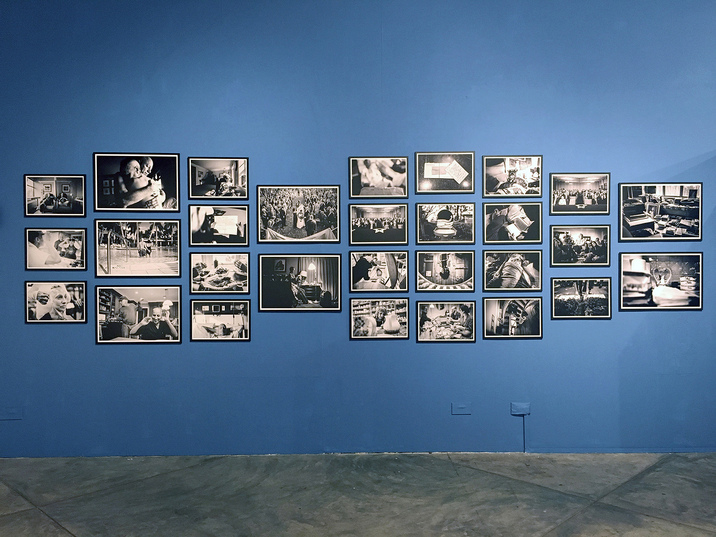-
From Current Issue
-
- Editor’s Letter Fire in the Heart
- Reviews I Gusti Ayu Kadek Murniasih
- Reviews 11th Seoul Mediacity Biennale: “One Escape at a Time”
- Dispatch Networked China
- One on One Monira Al Qadiri on Yukio Mishima
- Essays The rise of independent art spaces in pandemic-era Shanghai
- Features Tuan Andrew Nguyen
- Table of Contents
- Web Exclusives
- Archive
- Subscribe

R
E
V N
E
X
T
Installation view of “Women in Photography 2017” at Objectifs Centre for Photography and Film, Singapore, 2017. Courtesy Objectifs.
The third annual Women in Film and Photography showcase at Singapore’s Objectifs Centre for Photography and Film includes the group exhibition “Women in Photography 2017,” which is curated by Objectifs co-founder Emmeline Yong and presented at the center’s Chapel Gallery. In this year’s show, eight international documentary photographers explored fluid concepts of domesticity and identity, running the gamut from critical photojournalism to social commentary to immersive storytelling.
In the black-and-white series “A Life in Death” (2012–15), American photographer Nancy Borowick presents a stark visual memoir of the last days of her terminally ill parents. Her moving imagery follows their experiences in hospital undergoing treatment together, and at home with family. Each work is accompanied by Borowick’s gentle, sometimes humorous commentary, which offers context while diluting the bleak narrative of death. Hanoi-born Maika Elan subtly insinuates herself into the homes of dozens of Vietnamese homosexual couples—cooking, bathing, lolling in front of television. Sixteen color works from her photo essay “The Pink Choice” (2011–13) are insightful rejoinders that fly in the face of the lifestyle termed by Vietnam’s media as a “social evil.” Elan sparks her portraits of these households with immediacy and a subtle sensuality.
With a similar propinquity, a dozen color photographs in French documentarian Sandra Mehl’s long-term project “Ilona and Maddelena” (2015– ) follow the lives of two young sisters. Met by chance on a city street in southern France, the girls invited Mehl into their working-class home; the artist has since formed a bond with their family, and her broad imagery—both posed and spontaneous—depicts the two girls at play, in church and at home with family and pets. Mehl, a former sociologist, instills her studies of adolescent temerity and vulnerability with tenderness. Singaporean Bernice Wong chooses to document social issues in edgier terms. In her ongoing series “School of Hard Knocks” (2014– ), the artist raises issues of social inequality and poverty in Singapore—conditions rarely acknowledged by the wealthy city-state. Some two-dozen high-contrast black-and-white prints were tacked casually to a wall. This louche arrangement embodied Wong’s depiction of a single mother of seven—former convict, now mentor to at-risk youth—and her family. Along with ennui, tattoos and sutured wrists, Wong captures an underlying spirit of resilience rendered in velvety shadow and loving gesture.
Jannatul Mawa documents class and economic disparity in “Close Distance” (2011–14), a series of formal, almost ritualistic portraits of Bangladeshi women at home with their domestic helpers. Staged against brocade draperies or kitschy artwork, the seated women self-consciously eye the camera. Judging by clothing, skin color and body language, their status is obvious: Mawa comments that these photos might be an inadvertent ethnographic study, even as they reveal an imbalance of authority. The vivid series “Hair” (2014) by Canadian-Haitian Émilie Régnier features ten large diptych-style photos hanging from the gallery ceiling. Based in Ivory Coast, Régnier assembles a chronicle of contemporary beauty and self-image in West African society, vis-à-vis Western culture. Using an old Pentax camera with a 50 mm lens and expired film unearthed at a local market, the artist adopted a negative-splicing technique that presents dual perspectives of women and their intricate hairstyles (as inspired by Western celebrities), evoking style books found in local hair salons. The analog process (or perhaps outdated film emulsion) tinges Régnier’s assured imagery with a vivacious radiance.
In “Today’s Life and War” (2008), Iranian photographer Gohar Dashti stages metaphorical tableaux in an imaginary battlefield. Dashti translates her personal experiences during the Iran-Iraq War (1980–88) into what could be described as documentative-performance art. These dozen muted color images are intended to convey the emotional life of her generation: a young couple takes up housekeeping—reading the newspaper, drinking tea, hanging laundry—against the backdrop of a blasted landscape, burned-out cars and sandbag bunkers. Inscrutable, they show no emotion as they go about daily “life.” While Dashti stages the terrifying disconnect between “normalcy” and conflict, Bieke Depoorter of Belgium deliberately propels herself into uncertainty. “I Am About to Call it a Day” (2010–14) is theater; it is a performance of sorts by the artist, yet does not deviate from the purpose of documentary. Traveling in the US, Depoorter asked strangers to put her up for a night—with the proviso that she be allowed to photograph them. Depoorter is no impartial observer: she has an eye for the surreal, and for the anecdotal. Her mannered color images of dull-eyed folk at home in bed, in the toilet or in cluttered rooms glowing with fairy lights may be factual, but they are fragmented and, at times, mystifying. Yet in these glimpses of an enervated, small-town America, the works are as much nuanced photojournalism as eccentric storytelling.
Though the presentation encompassed widely differing styles and approaches, “Women in Photography 2017” is beautifully coherent, an elegant blend of documentary, social critique and idiosyncratic observation. The underlying connectivity that energizes these eight distinctive photographers is an intuitive, textured engagement with their diverse subjects—and this is the eloquence behind their imagery.
BIEKE DEPOORTER, “I Am About to Call It a Day,” 2010–14, digital fine art print, 40 × 60 cm. Courtesy the artist.
“Women in Photography 2017” is on view at Objectifs Centre for Photography and Film, Singapore, until November 19, 2017.
To read more of ArtAsiaPacific’s articles, visit our Digital Library.











